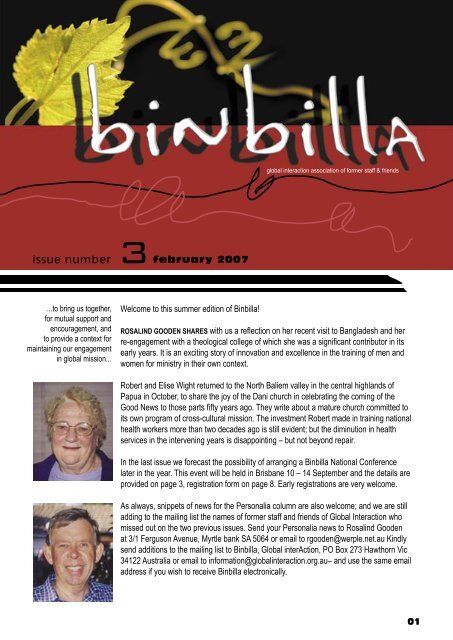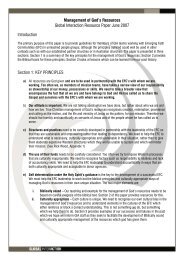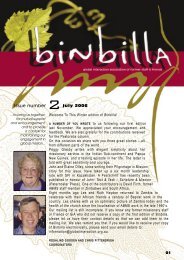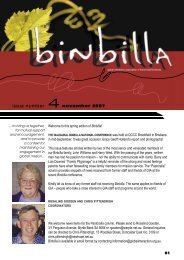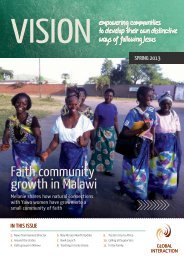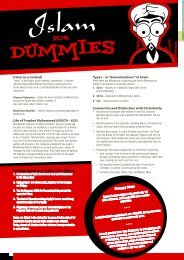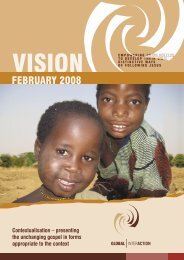Welcome to this summer edition of Binbilla ... - Global Interaction
Welcome to this summer edition of Binbilla ... - Global Interaction
Welcome to this summer edition of Binbilla ... - Global Interaction
You also want an ePaper? Increase the reach of your titles
YUMPU automatically turns print PDFs into web optimized ePapers that Google loves.
BINBILLA NATIONAL CONFERENCE10 - 14 SEPTEMBER 2007THE INAUGURAL BINBILLA NATIONAL CONFERENCE will beheld at QCCC Brookfield, Brisbane, commencing withdinner on Monday evening 10th September and concludingwith breakfast on Friday 14 th .QCCC Brookfield is situated only 25 minutes from theBrisbane CBD in a beautiful forest park. The facilitiesprovide a quality and affordable conference venue.The centre features a swimming pool, new kitchen anddining facilities, and existing accommodation has beenrefurbished <strong>to</strong> ‘motel style’ standard. All accommodationand main meeting areas are fully air conditioned.Further details are available on the QCCC website(www.qccc.com.au.)The basic accommodation arrangement is two bedroomunits, with two or, in a few cases, three beds <strong>to</strong> a room andshared bathroom and <strong>to</strong>ilet facilities. (Accommodation forone person <strong>to</strong> a room is available on a limited basis onlyand at a slightly higher tariff.)We are anticipating at least 60 guests. The <strong>to</strong>tal cost isapproximately $275.00 per person. This includes thefull cost <strong>of</strong> accommodation and meals ($198.00), threeafternoon excursions and administration costs includingguest speaker fees.Special dietary meals (i.e. gluten-free and vegetarian) areavailable and may attract additional fees. All meals areserved buffet style, so guests have control over what theyselect (e.g. low GI and low fat.)Each day will begin with a worship session, including aBible study presented by Rev Dr Stan Nickerson, a formerPrincipal <strong>of</strong> the Baptist Theological College <strong>of</strong> Queensland.Stan is a gifted exposi<strong>to</strong>r – with a delightful wry sense <strong>of</strong>humour! The remainder <strong>of</strong> the morning and evening afterdinnersessions will include presentations from the <strong>Global</strong><strong>Interaction</strong> Direc<strong>to</strong>rs on current and future directions,sharing s<strong>to</strong>ries <strong>of</strong> contemporary events in our own livesand prayer for <strong>Global</strong> <strong>Interaction</strong> ministries around theworld. Ample time will be provided for chatting with formermissionary colleagues and <strong>Global</strong> <strong>Interaction</strong> friends.The afternoon excursions will include the coastal andhinterland areas, within easy reach <strong>of</strong> Brisbane, and acultural event.A number <strong>of</strong> people attending the <strong>Binbilla</strong> conferenceplan <strong>to</strong> add value <strong>to</strong> their travel <strong>to</strong> the “Sunshine State”by having a holiday on the Gold or Sunshine coast, eitherprior <strong>to</strong> or following the conference. The weather in theBrisbane and near coastal areas in September is generallymild – cool enough for a blanket at night and pleasantlywarm during the day.Arrangements can be made <strong>to</strong> meet guests arriving inBrisbane by coach, train or air (Brisbane airport) andtransport them <strong>to</strong> QCCC Brookfield.If you wish <strong>to</strong> attend the conference please complete andmail the registration form on page 8 <strong>to</strong> Chris Pittendrighat the address indicated, <strong>to</strong>gether with a deposit <strong>of</strong>$100.00 (cheque or money order). The closing date is 31May. However, early registration would be appreciated.(Please make out cheques and money orders <strong>to</strong> <strong>Global</strong>interaction.) The balance is required by 31 July.03
4 Résumé français 2012 ¥ 9 ∂personnes de plus de 65 ans seront atteintesau cours de la suite de leur vie dedémence. Plus une personne est vieille, plusles risques sont élevés. En moyenne le tauxde patients atteints de démence est de 60%des services de soins stationnaires. En Allemagneaujourd’hui 11 millions de personnessont <strong>to</strong>uchées. Ce chiffre devrait augmenterd’environ 1,7 millions jusqu’en 2030. Le défilié à cette évolution ne s’impose que trèslentement et difficilement dans laconscience de la société.La démence joue dans <strong>to</strong>utes les formesd’habitat pour la vieillesse un rôle de plus enplus important et transforme l’architecturedes maisons de soins stationnaires. Presque60% des patients sont gérés dans leur environnementfamilial. à côté de cela il existedes <strong>of</strong>fres de prise en charge stationnairesou semi-stationnaires spécialisées dans lesmalades atteints de démence.Se rappeler et s’orienter, ces deux facultéscentrales commencent à diminuer dès le débutde la maladie. En même temps le besoinde protection et de sécurité augmente. Audébut le logement habituel répond à ces besoinset avec la progression de la maladierester chez soi devient de plus en plus difficileet compliqué. Souvent les personnes atteintesde démence sont un danger pourelles-mêmes et pour les autres. En plus cheznombreuses d’entre elles le besoin de bougeraugmente fortement. Un déménagementdevient inévitable.Les formes d’habitat pour les personnes atteintesde démenceDes formes d’habitation en cohabitation sesont développées en plus des asiles desoins pour accueillir des personnes atteintesde démence évolutive. Avec l’aide de servicede soin ambulant il est possible d’accueillirentre six et huit patients. Il s’agit laplupart du temps de logements existants répartisdans des quartiers et qui sont adaptésgrâce à des modifications simples aux besoinsdes habitants. On construit aussi sescolocations pour déments dans des immeublesneufs. Elles sont caractérisées parleurs grandes pièces communes, la plupartdu temps avec une cuisine ouverte, plusieurssalles de bains et <strong>to</strong>ilettes. Chaquecolocataire dispose de sa propre chambrequi lui permet de se retirer.Les oasis de soinLe concept des oasis de soin a été mis aupoint pour les personnes dans des stadesde démence avancés, souvent obligés degarder la chambre et le lit. Six à huit personnesvivent ensemble dans une grandepièce. Leurs lits sont séparés par des rideauxou des cloisons mobiles. La lumièreet les couleurs sont conçues en fonction dela sensibilisation sensorielle des résidents.Une garde-malade est présente en permanenceet en position centrale dans la pièce.Le concept controversé dans le monde pr<strong>of</strong>essionneldes oasis de soin a pour objectifd’<strong>of</strong>frir aux personnes en phase finale dedémence la plus grande part possible departicipation au monde extérieur pour agircontre le phénomène d’isolement.Clarté et diversitéComme les personnes atteintes de démencene peuvent que très rarement exprimer leursimpressions sur leur perception spatialenous sommes obligés d’extrapoler à partirde leur comportement, ce qui pourrait êtrel’expression d’un bien-être. Même si la rechercheest encore à ses débuts dans cedomaine certains principes formels s’imposent.Les personnes démentes ne soufrentpas seulement de diminution cognitive, leurcapacité visuelle et auditives sont souventréduites. L’architecture pour les démentsdoit <strong>to</strong>ujours simplifier l’orientation et exprimerun sentiment de sécurité. Une structurespatiale claire qui puisse être rapidement etintuitivement perçue est une condition. Lescontrastes de couleur entre les sols et lesmurs, qui peuvent encore être renforcés parl’éclairage, sont de véritables aides. Les<strong>to</strong>ns brillants ou bleus des revêtements desol sont à éviter puisque les résidents pourraientles confondre avec des surfacesd’eau et ne pas vouloir marcher dessus. Les<strong>to</strong>ns chauds et soutenus sont mieux différenciéspar les personnes âgées que les<strong>to</strong>ns pastels ou froids. Les traitements descouloirs et l’organisation des espaces communsdoivent tenir compte <strong>to</strong>ut particulièrementdes limites cognitives des résidents.Plutôt que des suites d’espaces complexesil est préférable de favoriser les parcoursdroits qui vont directement au but. Cela nesignifie d’aucune manière un re<strong>to</strong>ur aux circulationsde couloirs infinis qui rappellentdes programmes institutionnels, les circulationsdoivent être rythmées par la couleur, lalumière et les revêtements de sol <strong>to</strong>utcomme par des exceptions à la ligne droite.Beaucoup de plans permettent aux résidentset résidentes de faire des <strong>to</strong>urs : enempruntant les couloirs ils reviennent <strong>to</strong>ujoursà leur point de départ. De cette façonles personnes atteintes de démence qui ressententsouvent un fort besoin de mouvement,peuvent être mobiles dans un espaceprotégé. Ces parcours en boucle doiventêtre aussi organisés selon un principe défini.Les couloirs conçus comme des sectionsd’arc de cercle ne se sont pas avérés satisfaisants.Les couloirs en cul-de-sac ne posentpas de problème quand ils animent, àleur extrémité, les habitants à faire demi<strong>to</strong>ur,par exemple par un élargissement formantcomme une petite place. Dans l’idéalon peut éviter les couloirs en tant que tels.Les chambres de résidents donnent alors<strong>to</strong>utes sur la pièce centrale dans laquelle oncuisine et prend les repas ensemble. Cetteforme n’est pratiquement réalisable quedans les bâtiments neufs. Comme les résidentsrestent pratiquement exclusivement àl’intérieur de leur foyer il est indispensablede créer des atmosphères différentes à l’intérieurmême de celui-ci. Cette possibilitéde choix du lieu de séjour, en fonction desgoûts et de l’humeur du moment, est l’expressiond’une qualité de vie qui ne doit pasêtre négligée pour les résidents. La diversitéformelle, permettant une grande variétéd’expériences sensorielles est une donnéearchitec<strong>to</strong>nique centrale dans le soin.Ensemble dans les quartiersL’intégration et la formation de réseaux sontdes concepts clef pour le futur de l’habitatdans le grand âge. La notion de « quartier »forme le cadre spatial de cette représentationsociale d’une vie plus proche et plusdisponible les uns pour les autres. Dans cetespace social plus accessible les personnesâgées ne doivent pas vivre dans des institutionsspécifiques. Au lieu de cela leurs quartiersseront adaptés à leurs besoins spécifiquespour permettre la vie, ensemble, desjeunes et des vieux. Dans les quartiers lesréseaux de voisinage et l’engagement ci<strong>to</strong>yencomplètent le soutient pr<strong>of</strong>essionnelpour les personnes âgées. Dans cette optiqueles Pays Scandinaves et la Hollandesont assez exemplaires. Dans ces pays lanotion de quartier est déjà mise en œuvresous différentes formes. Ce concept est uneétape importante sur la voie de l’intégrationdes personnes âgées et sur<strong>to</strong>ut des personnesnécessitant des soins. C’est aussiune réaction à la transformation démographique.Les structures existantes des soinset des aides ne sont pas adaptées à l’augmentationdu nombre des personnes nécessitantde l’aide. Déjà aujourd’hui le secteurdes soins souffre d’une pénurie éclatante depersonnel soignant. De la même façon lesoutient des familles qui assurent aujourd’huiune grande partie de la prise encharge des malades ne pourra plus assurerdans ces conditions. Il est indispensable deprévoir de nouvelles formes de prise encharge. Les concepts de quartier s’appuientsur les trois piliers du logement adapté autroisième âge, de l’aide sociale et des soins.La première condition est de construire deslogements qui permettent à leurs habitantsde vivre le plus longtemps possible de façonindépendante. Le soutien social comprendles conseils et la coordination des différentsservices de soins ambulants avec l’aidequotidienne. Le troisième pilier représenteles <strong>of</strong>fres pour les personnes nécessitantdes soins lourds. Dans ce cas là les traitementssont effectués en petits groupes. Demême façon la dernière phase de vie doitavoir sa place dans les quartiers. Il est importantd’intégrer les hospices qui sont leplus souvent aménagés dans des structuresexistantes. Le succès des projets de quartierdépend fortement de facteurs faibles.La participation de <strong>to</strong>us les habitants et lacoopération étroite des acteurs des réseauxsociaux sont décisifs. Seules les coopérationsentre les administrations communales,l’économie immobilière, les prestataires deservice de soin et <strong>to</strong>utes les autres initiatives
UBILEE & FUTURE HEALTH NEEDSROBERT & ELISE WIGHTFor me, personally, the challenge concerning the HealthProgram was paramount. At Makki I met with a deputation<strong>of</strong> nine manteris (medical workers) and assistants,including Ndaibet, Wene, Amos, and others with whomI had worked and helped train. They were accompaniedby new trainees who, as in earlier days, were selectedand supported by the church. I was <strong>to</strong>ld that others werelocated in Wamena, the high plateau and many othervillages. In spite <strong>of</strong> the recent massacre, there are almosttwenty medical workers at different levels <strong>of</strong> training andexperience.They discussed their payments, supplies from thegovernment, preparing monthly reports, weighing babies,clinics for children under 5, immunization programstargeting infants at 2, 4 and 6 months with DPT Polio andHepatitis B, using disposable syringes, ante-natal careand promoting breast feeding for two years. Vitamin Acapsules are given <strong>to</strong> children up <strong>to</strong> age five years.since its inception.) The program would need <strong>to</strong> involvekey personnel from throughout Papua. It should also beculturally appropriate, sustainable and open particularly forthe indigenous Papuan community, but not entirely.The response so far has been positive, and 2008could be a target date, given the planning andnegotiating <strong>to</strong> be done.Please pray for <strong>this</strong> vision <strong>to</strong> be realised in a way thatassists our brothers and sisters in Papua and bringsglory <strong>to</strong> the One who loved us <strong>to</strong> death.However, the medical problems are immense. Withno permanent doc<strong>to</strong>r in Wamena and no doc<strong>to</strong>r in theNorth Baliem, emergency care is almost non existent. Totransfer someone <strong>to</strong> Jakarta is almost impossible and <strong>to</strong>oexpensive and ambulance travel is a hazard. There is alack <strong>of</strong> regular support for upgrading and refreshing skills.I have a list <strong>of</strong> requests which should satisfy thegenerosity <strong>of</strong> interested donors. But the one challengefor me was <strong>to</strong> pursue the possibility <strong>of</strong> setting up abranch <strong>of</strong> the International School <strong>of</strong> Health, similar <strong>to</strong>the one in Adelaide run by Pr<strong>of</strong>essor Tony Radford atFlinders University. (I have been engaged in the program05
PERSONALIAKEEPING EACH OTHER INFORMED & IN CONTACTIN RECENT YEARS, a number <strong>of</strong> former <strong>Global</strong> <strong>Interaction</strong>staff who served in Papua New Guinea have publishedtheir s<strong>to</strong>ry <strong>of</strong> missionary service. The latest addition isTONY CUPIT’S book, Fire in their Bones. It is a well-writtenaccount <strong>of</strong> his seven years – from the mid 1960’s – as alinguist, Bible transla<strong>to</strong>r and church advisor. Tony weaves<strong>to</strong>gether the s<strong>to</strong>ry <strong>of</strong> his life with MARGARET and their threeyoung children and the Kyaka Enga people, amongstwhom they lived, at Lumusa in the Western HighlandsProvince. He also chronicles the development <strong>of</strong> thenascent church in those parts in what Dr Ken Manleydescribes as a ‘definitive period in the life <strong>of</strong> the Baptistmovement in Papua New Guinea.’ Copies <strong>of</strong> Fire in theirBones are available from Tony livingwater@bigpond.net.auand the <strong>Global</strong> <strong>Interaction</strong> <strong>of</strong>fice in Hawthorn. The cost is$15.00 plus postage.GWENDY RIDDEN (India, Papua New Guinea, Zambia,Zimbabwe and Malawi) has just returned from sixmonths in southern Africa. ‘It was very encouraging andworthwhile, writes Gwendy, ‘and God blessed us with manymore children trusting Christ for salvation.’Early last August BERYL KIRKWOOD (India) had major oralsurgery <strong>to</strong> remove low grade cancer which had invaded herhard palate, upper jaw, salivary and lymph glands. Berylsays it is taking time ‘getting used <strong>to</strong> a different mouth heldup with muscle taken from my forearm.’ In the interveningmonths she has resumed teaching Creative Writing atU3A and leading a young women’s Bible study – andother ministries – at her church, North West Community inSydney.TREVOR AND JOAN ROSS (Papua New Guinea) left forVietnam on 10 February <strong>to</strong> spend time with their youngestson, Peter, who teaches English in a Vietnamese school.Trevor and Joan live at Currimundi, on the QueenslandSunshine Coast, within twenty minutes driving time <strong>of</strong>their daughters Charis and Faith. They are kept busyat the Kawanalife Church where Joan is the Missions’Coordina<strong>to</strong>r and Trevor a Home Group leader.At the end <strong>of</strong> February LES AND VAL MERRIN (Thailand)are commencing a “Friends <strong>of</strong> GiA” group in their home atThornlands in the “Bayside” area in the southern suburbs<strong>of</strong> Brisbane. Les and Val have recently been involved inselecting a <strong>Global</strong> <strong>Interaction</strong> house at Welling<strong>to</strong>n Point forthe short-term use <strong>of</strong> outgoing and returning staff.06HEATHER AND CHRIS PITTENDRIGH will be attending theAsian Baptist Federation Congress in Chiang Mai,Thailand, from 2 – 6 May. Chris has the oversight <strong>of</strong> themission workshops. He will be assisted by his successor at<strong>Global</strong> <strong>Interaction</strong>, CHRIS BARNDEN.JOHN WILLIAMS celebrated his ninetieth birthday on 23December. The occasion was marked by morning tea(several days earlier) at the <strong>Global</strong> <strong>Interaction</strong> national<strong>of</strong>fice in Hawthorn and afternoon tea on the day at theBaptist church “JD” attends at Doncaster East. Johnis in good fettle. He lives with his sister, Les, at theTemples<strong>to</strong>we Orchards retirement village. A number <strong>of</strong> hisformer <strong>Global</strong> <strong>Interaction</strong> colleagues were in attendance,including Trevor and Gwen Farmilo, Tony and MargaretCupit, Bill and Audrey McFarlane, Basil Brown and Ge<strong>of</strong>fand Francis Holland.RAY BURMAN (Thailand) had a bone marrow biopsy andother tests in early February <strong>to</strong> locate the suspectedpresence <strong>of</strong> cancer somewhere in his body. Ray asksfor prayer. Nantana has recently returned from Thailand,Andrew is planning <strong>to</strong> get married in Korea later in theyear, Justin is working part-time producing machines <strong>to</strong>help people with breathing problems and JJ is half-waythrough an accountancy traineeship.SETON AND BARBARA ARNDELL spent most <strong>of</strong> last yeartravelling round Australia by caravan and <strong>to</strong>ok theopportunity <strong>to</strong> visit many Baptist churches and a number<strong>of</strong> Aboriginal communities. Se<strong>to</strong>n continues his work with<strong>Global</strong> <strong>Interaction</strong> as chair <strong>of</strong> the Missiological AdvisoryCommittee and Barbara serves as secretary <strong>of</strong> the <strong>Global</strong>Mission Committee in their local church at Gosford NSWTREVOR AND GWEN FARMILO wrote, ‘We had a letter fromVAL JOHNSTON. Val and JOHN have been serving at theBarnes School at Devlali, about 200 kms. north <strong>of</strong> Mombai(Bombay). They spent the school holidays visiting placesthey know in India <strong>to</strong> say “goodbye”! Previously theyhave been located in hill country districts and <strong>this</strong> timethey have found the heat at Devlali hard <strong>to</strong> cope with. Ontheir goodbye trip the dust and pollution and heat <strong>to</strong>ok its<strong>to</strong>ll and they’ve finally agreed the time has come <strong>to</strong> returnhome – which they will do in April’.Trevor and Gwen’s grand-daughter STEFANIE (TIM’Syounger daughter) was married on the 17 February – in agarden setting in the Dandenongs. JULIE, their daughter, isthe <strong>of</strong>ficiating minister.
MARY AND ROGER BRYSON wrote in their New Year letterthat Roger concluded five satisfying years at the FlindersStreet Baptist Church in March, 2006. After four months<strong>of</strong> property work, Roger became Manager <strong>of</strong> the AdelaideCentral Market. Voluntary work with Bright Futures(overseas aid) and 5 RPH (radio for print handicapped)has replaced Roger’s involvement with <strong>Global</strong> <strong>Interaction</strong>in PNG. Roger and Mary recently moved <strong>to</strong> Strathalbyn,a pretty country <strong>to</strong>wn 55 kms. southeast <strong>of</strong> Adelaide and50 minutes travel time by car. “Our house plans are withCouncil and we are hoping <strong>to</strong> move-in by next Oc<strong>to</strong>ber. Inthe meanwhile we are renting a house in Strathalbyn <strong>to</strong>keep an eye on the building process.”JOHN AND ELAINE OLLEY have returned from leadingthe <strong>Global</strong> <strong>Interaction</strong> team in Kazakhstan. They write,“Before we left for Kazakhstan we were both approached<strong>to</strong> be involved back at the Baptist Theological College <strong>of</strong>WA for the next two years (part-time, 2 days/week). Johnhas begun as Academic Dean and Elaine as Chaplain.”Keep up the good work!GEORGE STUBBS writes, ‘You have probably heard that Ihave retired from full-time employment with CorrectionalCentres Chaplaincy. That means MARGARET has retired<strong>to</strong>o, though we both are doing some volunteer jail work.I go <strong>to</strong> Arthur Gorrie Correctional Centre each Fridayas a chaplain and Margaret does occasional visiting atthe Brisbane Women’s Correctional Centre. It has beengreat not having a flat-out routine since July 1. RecentlyJONATHAN (JONA) and family moved <strong>to</strong> Tasmania. He findsthat the hot and humid Queensland climate does not sui<strong>this</strong> medical needs; hence the move <strong>to</strong> Tasmania. Jona hada mo<strong>to</strong>rbike accident in May, 2003, and he has been ona disability pension ever since. He has lost the use <strong>of</strong> hisright arm and he is considering an amputation below theelbow and the fitting <strong>of</strong> prosthetic hand. We pray with himfor the right decision. The rest <strong>of</strong> our kids are well, also thegrandkids.’A diverse and interested group <strong>of</strong> people last Oc<strong>to</strong>ber <strong>to</strong>okup the invitation <strong>of</strong> the Baptist Church in Papua (formerlythe Indonesian province <strong>of</strong> Irian Jaya) <strong>to</strong> attend the Jubilee<strong>of</strong> the coming <strong>of</strong> the Gospel <strong>to</strong> the Dani people. IANGRUBER, who was the first <strong>Global</strong> <strong>Interaction</strong> person <strong>to</strong>enter the North Baliem valley (1957), was accompanied byhis two daughters, BERYL GRIFFIN and JANET KIDD. RUTHCHARLES had her daughters BRONWYN WILKINSON andMARGARET REYNE with her, and ELIZABETH LAWRENCEtraveled with her son, PETER. Then there were BRIAN ANDGLYNNE BEAVER, DENNIS BROWN, ROB AND ELISE WHITE andJEAN (CROWE) SMITH. JOE SHERRIFF went a little ahead<strong>of</strong> the main group <strong>to</strong> help ROD AND HELEN BENSLEY withthe needed preparations. CHRIS BARNDEN and KEITHJOBBERNS went from Moore Potter House. IVAN JAMES,<strong>Global</strong> <strong>Interaction</strong> Board Chairman, was accompanied byhis wife, BARBARA. LLOYD AND BETH DRAYTON – from theFootscray Baptist Church where RAINER SCHACK is theirminister – completed the party. We look forward <strong>to</strong> hearingmore <strong>of</strong> their impressions!DR KEN MANLEY was the major speaker at the BaptistResearch Forum 2 held in Sydney in January. Ken gavethree excellent addresses on the mission heart <strong>of</strong> Baptistidentity. (A book containing these addresses, and othermaterial presented at the forum, will be published laterin the year.) Ken’s third address, on the challenges <strong>of</strong>the present, was particularly relevant in its reflections onthe changes in <strong>Global</strong> interaction in recent years and themissional church movement.DAVID AND JOHAN GLADSTONE (Papua New Guinea) areworking in Uganda and the Sudan with a New Zealandbased organisation, <strong>Global</strong> Connections in Mission.Recently, two national co-workers <strong>to</strong>ok out lawsuits againstDavid and Johan based on fabricated “evidence”. It hasbeen a difficult time for the Glads<strong>to</strong>nes and they requestprayer for a just outcome for themselves and the nationalchurch with whom they work.07
Rev Chris Pittendrigh15 Woodlea StreetDONCASTER EAST VIC 3109Please enclose a deposit <strong>of</strong> $100.00 and mail <strong>to</strong>:Email address (if available):Telephone: homemobileworkPostal Address:Name:REGISTRATION FORMBINBILLANATIONALCONFERENCE10 - 14 SEPTEMBER 200708binbillais produced byPO Box 273HawthornVic<strong>to</strong>ria 3122AustraliaROSALIND GOODEN’S STORYCONTINUES(CONTINUED FROM PAGE TWO)All three have had links with <strong>Global</strong> <strong>Interaction</strong> overthe years. So it was a great occasion – 7 BTh, 14 MAin Christian studies and 3 MDiv – with plenty <strong>of</strong> pomp,ceremony and colour. The MAs had blue hoods and theMDivs red.The current enrolment <strong>of</strong> the College is 1,800 studentsand they meet in about 20 centres around the country,and <strong>of</strong>ten tu<strong>to</strong>red by one <strong>of</strong> the 75 BTh graduates alreadyproduced by the programme. Australian Baptists can bevery encouraged by the contribution we have made <strong>to</strong>leadership development in Bangladesh through people likeSimon Sircar and Gregory Marak. I trust that your interestwill continue <strong>to</strong> follow the new principal, Dr Pratap Gine,and his wife, Dipti. Pratap and Dipti have been teachingat Eastern Theological College in Johart, Assam. Both didpostgraduate studies at Whitley College, Melbourne, and,for a time, Dipti did volunteer work at Moore Potter Housecomputerizing the library collection.As part <strong>of</strong> the Graduation celebrations the College holdsinspirational meetings for its graduates. Travel was noteasy, as you can imagine; but the boycott was lifted on theTuesday, equipment was able <strong>to</strong> be brought in Wednesday,the meetings were held on Thursday and Friday and theGraduation ceremony on the Saturday. It was moving <strong>to</strong>share in the prayer; not just for the College events, but alsothe future <strong>of</strong> the country. A church in Korea sponsoredthese inspirational meetings and the pas<strong>to</strong>r was the guestspeaker.Dr Manfred Kohl, from Overseas Council International,was the chief guest for the graduation and he gave avery interesting assessment <strong>of</strong> the directions theologicaleducation is taking in the two-thirds world. It was a greattime.My time in Bangladesh was made even more pointedbecause I used it <strong>to</strong> prepare a paper on women in missionsfor the Baptist Research Forum in Sydney in January. Ithas challenged me <strong>to</strong> look very seriously at the reason whyEllen Arnold has become such an icon for the BangladeshBaptist Fellowship. If any <strong>of</strong> you have any clues, I’d bepleased <strong>to</strong> hear them.I have come away from CCTB wanting <strong>to</strong> ask, in <strong>this</strong> age <strong>of</strong>globalisation, what makes a leadership training programmeBangladeshi or, at least, suited <strong>to</strong> the context. I wonderwhat Ellen and her colleagues would think <strong>of</strong> the presentsituation.


